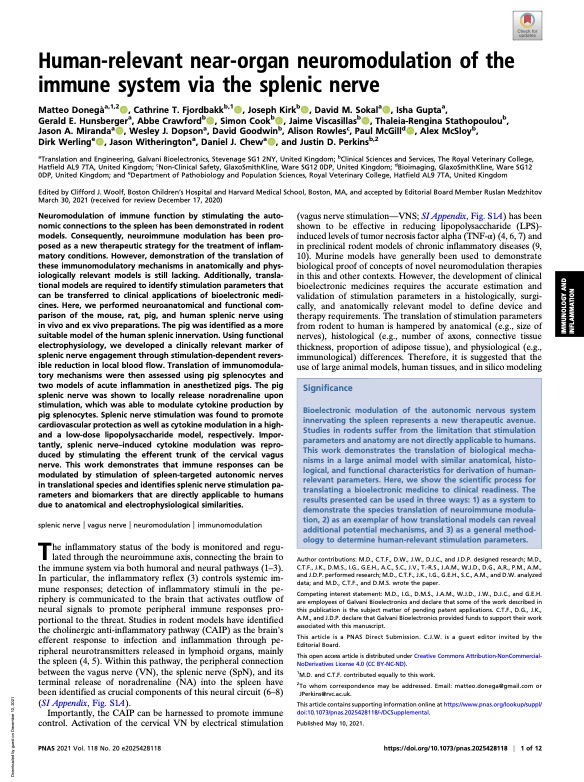M Donega
Human-relevant near-organ neuromodulation of the immune via the nerve
Donega, M; Fjordbakk, CT; Kirk, J; Sokal, DM; Gupta, I; Hunsberger, GE; Crawford, A; Cook, S; Viscasillas, J; Stathopoulou, TR; Miranda, JA; Dopson, WJ; Goodwin, D; Rowles, A; McGill, P; McSloy, A; Werling, D; Witherington, J; Chew, DJ; Perkins, JD
Authors
CT Fjordbakk
J Kirk
DM Sokal
I Gupta
GE Hunsberger
A Crawford
S Cook
J Viscasillas
TR Stathopoulou
JA Miranda
WJ Dopson
D Goodwin
A Rowles
P McGill
A McSloy
D Werling
J Witherington
DJ Chew
JD Perkins
Abstract
Neuromodulation of immune function by stimulating the autonomic connections to the spleen has been demonstrated in rodent models. Consequently, neuroimmune modulation has been proposed as a new therapeutic strategy for the treatment of inflammatory conditions. However, demonstration of the translation of these immunomodulatory mechanisms in anatomically and physiologically relevant models is still lacking. Additionally, translational models are required to identify stimulation parameters that can be transferred to clinical applications of bioelectronic medicines. Here, we performed neuroanatomical and functional comparison of the mouse, rat, pig, and human splenic nerve using in vivo and ex vivo preparations. The pig was identified as a more suitable model of the human splenic innervation. Using functional electrophysiology, we developed a clinically relevant marker of splenic nerve engagement through stimulation-dependent reversible reduction in local blood flow. Translation of immunomodulatory mechanisms were then assessed using pig splenocytes and two models of acute inflammation in anesthetized pigs. The pig splenic nerve was shown to locally release noradrenaline upon stimulation, which was able to modulate cytokine production by pig splenocytes. Splenic nerve stimulation was found to promote cardiovascular protection as well as cytokine modulation in a high and a low-dose lipopolysaccharide model, respectively. Importantly, splenic nerve-induced cytokine modulation was reproduced by stimulating the efferent trunk of the cervical vagus nerve. This work demonstrates that immune responses can be modulated by stimulation of spleen-targeted autonomic nerves in translational species and identifies splenic nerve stimulation parameters and biomarkers that are directly applicable to humans due to anatomical and electrophysiological similarities.
Citation
Donega, M., Fjordbakk, C., Kirk, J., Sokal, D., Gupta, I., Hunsberger, G., Crawford, A., Cook, S., Viscasillas, J., Stathopoulou, T., Miranda, J., Dopson, W., Goodwin, D., Rowles, A., McGill, P., McSloy, A., Werling, D., Witherington, J., Chew, D., & Perkins, J. (2021). Human-relevant near-organ neuromodulation of the immune via the nerve. Proceedings of the National Academy of Sciences, 118(20), https://doi.org/10.1073/pnas.2025428118
| Journal Article Type | Article |
|---|---|
| Acceptance Date | Mar 30, 2021 |
| Publication Date | 2021 |
| Deposit Date | Dec 10, 2021 |
| Publicly Available Date | Dec 10, 2021 |
| Journal | Proceedings of the National Academy of Sciences |
| Print ISSN | 0027-8424 |
| Electronic ISSN | 1091-6490 |
| Publisher | National Academy of Sciences |
| Peer Reviewed | Peer Reviewed |
| Volume | 118 |
| Issue | 20 |
| DOI | https://doi.org/10.1073/pnas.2025428118 |
| Keywords | splenic nerve; vagus nerve; neuromodulation; immunomodulation; CHOLINERGIC ANTIINFLAMMATORY PATHWAY; SYMPATHETIC-NERVES; STIMULATION; SPLEEN; RESPONSES; TORTUOSITY; DISEASE; SODIUM; REFLEX; SAFETY |
| Public URL | https://rvc-repository.worktribe.com/output/1553007 |
Files
oa
(233 Kb)
Image
Publisher Licence URL
http://creativecommons.org/licenses/by-nc-nd/4.0/
You might also like
Respiratory compromise in French bulldogs presented with intervertebral disc extrusion
(2023)
Journal Article
Respiratory compromise in French bulldogs presented with intervertebral disc extrusion
(2023)
Journal Article
Downloadable Citations
About RVC Repository
Administrator e-mail: publicationsrepos@rvc.ac.uk
This application uses the following open-source libraries:
SheetJS Community Edition
Apache License Version 2.0 (http://www.apache.org/licenses/)
PDF.js
Apache License Version 2.0 (http://www.apache.org/licenses/)
Font Awesome
SIL OFL 1.1 (http://scripts.sil.org/OFL)
MIT License (http://opensource.org/licenses/mit-license.html)
CC BY 3.0 ( http://creativecommons.org/licenses/by/3.0/)
Powered by Worktribe © 2025
Advanced Search

